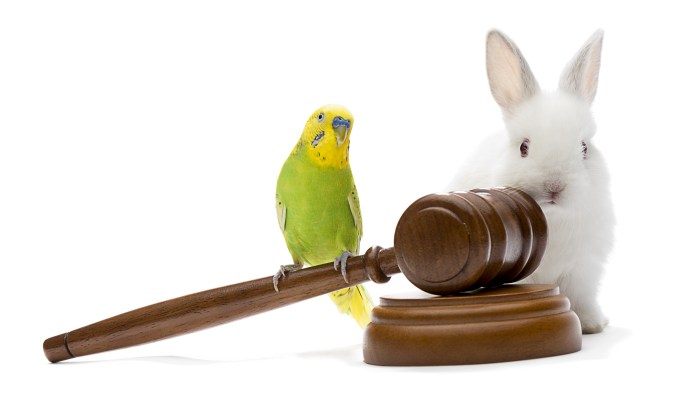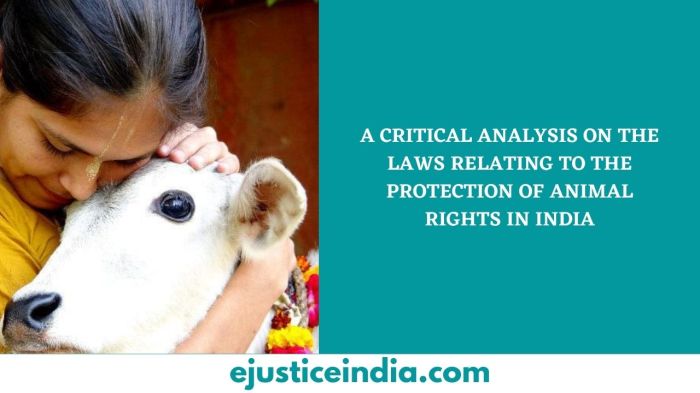
Embark on a journey through the world of animal rights and protection laws, where the welfare of our beloved creatures takes center stage.
From the legal landscape to the ethical considerations, prepare to delve into a realm filled with intriguing insights and thought-provoking discussions.
Animal Rights and Protection Laws
Animal rights and protection laws are put in place to ensure the well-being and welfare of animals. These laws aim to prevent cruelty, abuse, and neglect towards animals, as well as to promote their overall safety and rights.
Examples of Animal Rights and Protection Laws
- In the United States, the Animal Welfare Act sets standards for the treatment of animals in research, exhibition, transport, and by dealers.
- In the United Kingdom, the Animal Welfare Act 2006 consolidates and updates existing animal welfare legislation.
- In India, the Prevention of Cruelty to Animals Act, 1960, aims to prevent the infliction of unnecessary pain or suffering on animals.
Penalties for Violating Animal Rights and Protection Laws
- Violating animal rights and protection laws can result in fines, imprisonment, or both, depending on the severity of the offense.
- Penalties may also include confiscation of animals, prohibition from owning animals in the future, and mandatory attendance of animal welfare classes.
Evolution of Animal Rights Legislation
Animal rights legislation has evolved over the years to provide better protection for animals. Initially, laws focused on preventing overt acts of cruelty, but now they encompass a broader range of issues such as neglect, abandonment, and exploitation. The shift towards recognizing animals as sentient beings with their own rights has influenced the development of more comprehensive and stringent animal welfare laws.
Animals

Animals play a crucial role in our ecosystems and lives, and it is important to ensure their well-being and protection through legal measures. Let’s delve into the various legal protections and rights afforded to different types of animals.
Legal Protections for Different Types of Animals
- Pets: Pets are often considered members of the family, and as such, they are protected under laws that prevent cruelty and ensure their welfare. This includes laws against abuse, neglect, and abandonment.
- Livestock: Livestock animals raised for food production are also protected under laws that regulate their living conditions, transportation, and slaughter practices. These laws aim to minimize suffering and ensure humane treatment.
- Wildlife: Wildlife protection laws focus on conserving and preserving endangered species, habitats, and ecosystems. These laws regulate hunting, trade, and habitat destruction to prevent exploitation and extinction.
Rights Afforded to Animals
- Welfare: Animals have the right to be free from unnecessary suffering and cruelty. This includes access to food, water, shelter, and veterinary care to ensure their well-being.
- Living Conditions: Animals should be provided with adequate living conditions that meet their physical and behavioral needs. This includes space to move, exercise, socialize, and engage in natural behaviors.
- Treatment: Animals should be treated with respect and dignity, and their physical and psychological needs should be considered in all human interactions.
Role of Animal Rights Organizations
Animal rights organizations play a crucial role in advocating for legal protections for animals. They raise awareness about animal welfare issues, lobby for stronger laws, rescue and rehabilitate animals in need, and provide education and resources to the public to promote compassionate treatment of animals.
Impact of Strong Animal Protection Laws
Strong animal protection laws can significantly reduce animal cruelty by deterring abusive behavior, ensuring swift enforcement and prosecution of offenders, and promoting a culture of empathy and respect towards animals. In a hypothetical scenario, imagine a world where strict laws against animal abuse are enforced rigorously. This could lead to a decrease in cases of neglect, cruelty, and exploitation, ultimately improving the lives of countless animals and fostering a more compassionate society.
Livestock
Livestock animals, including cows, pigs, and chickens, face unique challenges when it comes to enforcing animal protection laws. Due to the large scale of agricultural operations and the demand for animal products, ensuring the welfare of these animals can be a complex task.
Regulations for Livestock Welfare
In order to improve the welfare of livestock animals, various regulations have been implemented. For example, the Humane Slaughter Act in the United States sets standards for the treatment of livestock animals during slaughter. Additionally, the European Union has regulations in place to protect the welfare of farm animals, including requirements for housing, feeding, and transportation.
Standards for Humane Treatment
The standards for humane treatment of livestock animals in agricultural practices include providing access to food and water, appropriate shelter, and veterinary care when needed. Farmers are also encouraged to use humane handling practices and avoid overcrowding in barns or pens.
Economic Implications
Implementing stringent animal protection laws for livestock farmers can have economic implications. Farmers may incur additional costs to meet the standards for animal welfare, which could lead to higher prices for consumers. However, there is also evidence to suggest that improving the welfare of livestock animals can lead to higher productivity and quality of products, ultimately benefiting both the animals and the farmers.
Wild Animals

Wild animals play a crucial role in maintaining the delicate balance of ecosystems around the world. The protection of these animals is vital for preserving biodiversity and ensuring the sustainability of our planet.
Significance of Wildlife Protection Laws
Wildlife protection laws are essential in preserving biodiversity by safeguarding the habitats of various species and preventing their exploitation. These laws regulate activities such as hunting, trafficking, and habitat destruction to ensure the survival of wild animals and maintain ecological harmony.
Enforcement Mechanisms for Protecting Wild Animals
- Creation of protected areas: Establishing national parks, wildlife reserves, and sanctuaries to provide safe havens for wild animals.
- Law enforcement agencies: Dedicated wildlife conservation units and task forces to combat poaching, illegal trade, and habitat destruction.
- Education and awareness: Raising public awareness about the importance of wildlife conservation and the consequences of harming wild animals.
Ethical Considerations in Balancing Human Needs with Wildlife Protection
Protecting wild animal habitats often involves ethical dilemmas, as human activities such as urbanization, agriculture, and infrastructure development may encroach upon these habitats. Striking a balance between human needs and wildlife protection requires careful planning, sustainable practices, and respect for the rights of wild animals to thrive in their natural environments.
Role of International Treaties and Agreements
International treaties and agreements play a crucial role in safeguarding the rights of wild animals by establishing global standards for wildlife protection and conservation. Treaties like the Convention on International Trade in Endangered Species of Wild Fauna and Flora (CITES) regulate the international trade of wildlife species to prevent exploitation and ensure their survival.
Last Recap
As we conclude our exploration of animal rights and protection laws, it becomes evident that these regulations play a crucial role in ensuring the well-being and safety of all creatures, great and small.
FAQ Section
What are some common penalties for violating animal rights laws?
Penalties can range from fines to imprisonment, depending on the severity of the offense and jurisdiction.
How do animal rights organizations contribute to the cause?
These organizations advocate for stricter laws, raise awareness, and provide resources for animal welfare.
What is the economic impact of stringent animal protection laws on livestock farmers?
While initial costs may rise, long-term benefits include improved animal welfare standards and consumer trust.





